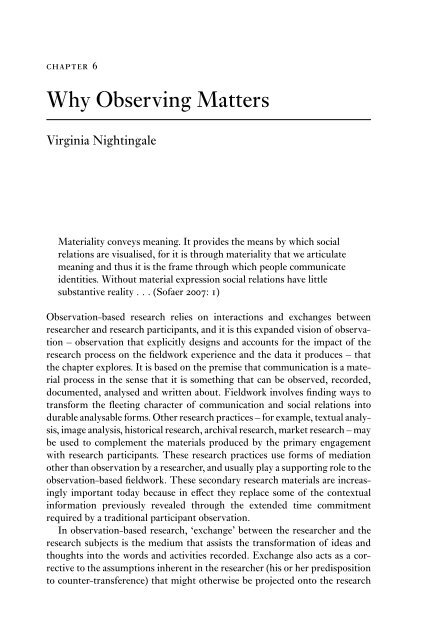Michael Pickering-Research Methods in Cultural Studies (Research Methods for the Arts and Humanities) (2008)
Create successful ePaper yourself
Turn your PDF publications into a flip-book with our unique Google optimized e-Paper software.
CHAPTER 6<br />
Why Observ<strong>in</strong>g Matters<br />
Virg<strong>in</strong>ia Night<strong>in</strong>gale<br />
Materiality conveys mean<strong>in</strong>g. It provides <strong>the</strong> means by which social<br />
relations are visualised, <strong>for</strong> it is through materiality that we articulate<br />
mean<strong>in</strong>g <strong>and</strong> thus it is <strong>the</strong> frame through which people communicate<br />
identities. Without material expression social relations have little<br />
substantive reality . . . (Sofaer 2007: 1)<br />
Observation-based research relies on <strong>in</strong>teractions <strong>and</strong> exchanges between<br />
researcher <strong>and</strong> research participants, <strong>and</strong> it is this exp<strong>and</strong>ed vision of observation<br />
– observation that explicitly designs <strong>and</strong> accounts <strong>for</strong> <strong>the</strong> impact of <strong>the</strong><br />
research process on <strong>the</strong> fieldwork experience <strong>and</strong> <strong>the</strong> data it produces – that<br />
<strong>the</strong> chapter explores. It is based on <strong>the</strong> premise that communication is a material<br />
process <strong>in</strong> <strong>the</strong> sense that it is someth<strong>in</strong>g that can be observed, recorded,<br />
documented, analysed <strong>and</strong> written about. Fieldwork <strong>in</strong>volves f<strong>in</strong>d<strong>in</strong>g ways to<br />
trans<strong>for</strong>m <strong>the</strong> fleet<strong>in</strong>g character of communication <strong>and</strong> social relations <strong>in</strong>to<br />
durable analysable <strong>for</strong>ms. O<strong>the</strong>r research practices – <strong>for</strong> example, textual analysis,<br />
image analysis, historical research, archival research, market research – may<br />
be used to complement <strong>the</strong> materials produced by <strong>the</strong> primary engagement<br />
with research participants. These research practices use <strong>for</strong>ms of mediation<br />
o<strong>the</strong>r than observation by a researcher, <strong>and</strong> usually play a support<strong>in</strong>g role to <strong>the</strong><br />
observation-based fieldwork. These secondary research materials are <strong>in</strong>creas<strong>in</strong>gly<br />
important today because <strong>in</strong> effect <strong>the</strong>y replace some of <strong>the</strong> contextual<br />
<strong>in</strong><strong>for</strong>mation previously revealed through <strong>the</strong> extended time commitment<br />
required by a traditional participant observation.<br />
In observation-based research, ‘exchange’ between <strong>the</strong> researcher <strong>and</strong> <strong>the</strong><br />
research subjects is <strong>the</strong> medium that assists <strong>the</strong> trans<strong>for</strong>mation of ideas <strong>and</strong><br />
thoughts <strong>in</strong>to <strong>the</strong> words <strong>and</strong> activities recorded. Exchange also acts as a corrective<br />
to <strong>the</strong> assumptions <strong>in</strong>herent <strong>in</strong> <strong>the</strong> researcher (his or her predisposition<br />
to counter-transference) that might o<strong>the</strong>rwise be projected onto <strong>the</strong> research



